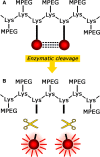Obtaining adequate surgical margins in breast-conserving therapy for patients with early-stage breast cancer: current modalities and future directions
- PMID: 19609829
- PMCID: PMC2749177
- DOI: 10.1245/s10434-009-0609-z
Obtaining adequate surgical margins in breast-conserving therapy for patients with early-stage breast cancer: current modalities and future directions
Abstract
Inadequate surgical margins represent a high risk for adverse clinical outcome in breast-conserving therapy (BCT) for early-stage breast cancer. The majority of studies report positive resection margins in 20% to 40% of the patients who underwent BCT. This may result in an increased local recurrence (LR) rate or additional surgery and, consequently, adverse affects on cosmesis, psychological distress, and health costs. In the literature, various risk factors are reported to be associated with positive margin status after lumpectomy, which may allow the surgeon to distinguish those patients with a higher a priori risk for re-excision. However, most risk factors are related to tumor biology and patient characteristics, which cannot be modified as such. Therefore, efforts to reduce the number of positive margins should focus on optimizing the surgical procedure itself, because the surgeon lacks real-time intraoperative information on the presence of positive resection margins during breast-conserving surgery. This review presents the status of pre- and intraoperative modalities currently used in BCT. Furthermore, innovative intraoperative approaches, such as positron emission tomography, radioguided occult lesion localization, and near-infrared fluorescence optical imaging, are addressed, which have to prove their potential value in improving surgical outcome and reducing the need for re-excision in BCT.
Figures



References
-
- Heron M. Deaths: leading causes for 2004. Natl Vital Stat Rep. 2007;56:1–95. - PubMed
Publication types
MeSH terms
LinkOut - more resources
Full Text Sources
Medical

